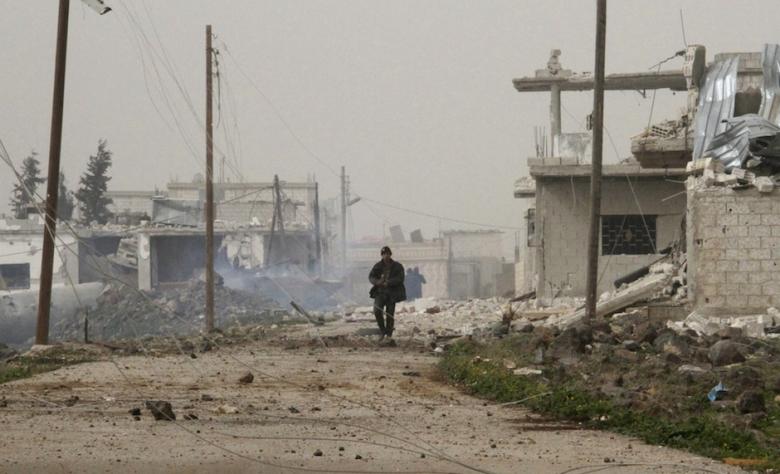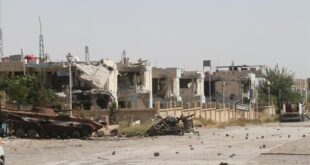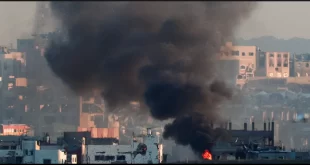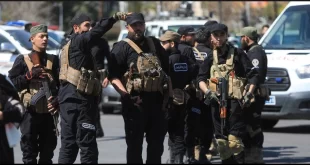
Feb 12, 2015, Al Akhbar
The steady advances by the Syrian army toward villages in southern Syria allowed the return of Deir al-Adas, al-Danaji, Deir Maker, and the hills of Masih, Mer’i, al-Arous, and al-Sarjah to the control of the state. Meanwhile, Zahran Aloush has renewed his threats against the Syrian capital, Damascus.
Damascus Countryside — Battles continue to rage in the Daraa and Damascus countryside. On Wednesday, the Syrian army settled battles on several fronts in villages located northwest of Daraa. Military checkpoints were installed in areas that were captured, such as al-Danaji and Deir Maker. In a major development, the Syrian army announced that it has taken control of the village of Deir al-Adas, the gateway to the northern countryside of Daraa, which borders the eastern countryside. The Syrian army and its allied forces have established a new reality on the ground, which indicates that southern Syria will not remain under the control and grip of the armed opposition factions.
Due to the intensification of fighting in Tal Qarin since Wednesday afternoon, the army’s next destination will likely be Kafr Shams, the main supply line to the militants in the province’s western countryside.
In Kafr Shams, the Syrian army forces started the battles with continuous missile and artillery shelling against al-Nusra Front strongholds in the town. During the past 24 hours, the army has sought to foil infiltration attempts by armed opposition groups seeking to support their exhausted allied forces in Kafr Shams, where nearly 31 al-Nusra Front members are said to have been killed and dozens others wounded. Informed military sources revealed that “significant arrests have been made during the clashes yesterday.”
These operations were carried out before the Syrian army announced that “successive qualitative achievements have been made in several areas in the Damascus, Quneitra, and Daraa countryside. The army units restored security and stability in the towns of Deir al-Adas, al-Danaji, and Deir Maker, tightened their control over Tal Masih, Tal Mer’i, Tal al-Arous, and Tal al-Sarjah, and wiped out large numbers of al-Nusra Front terrorists.”
The military statement issued on Wednesday evening added that “the importance of the successes achieved by the Syrian Arab Army soldiers in the southern region is that they bolster and secure the Damascus-Quneitra axis and the Damascus-Daraa axis, and cut off the supply and communication lines between terrorist outposts in the western Damascus countryside and the Daraa and Quneitra countryside. Also, control over the main hills can further bolster military successes in this area.”
After taking control of strategic hills, the Syrian army appears to be close to recapturing the areas of Khirbet Sultana and Talat Fatima, where militant activity has ceased since Wednesday night following intensive artillery strikes by the Syrian army against armed opposition posts there.
As loudspeakers at mosques appealed to militants to withdraw from Tal al-Harah, the Syrian army carried out an advanced ambush, killing and wounding a number of al-Nusra Front militants on the Qarfa- al-Shaykh Maskin road in the Daraa countryside. This indicates that the ongoing battles may extend to a number of areas in the eastern Daraa countryside, which had witnessed relative calm after the clashes moved to the province’s western countryside.
The surprise attack by the army prompted the insurgents to try to merge their military capabilities, at times leading to disagreements within the same group.
The military and field coordination between the factions — al-Nusra Front, al-Furqan Brigade, Tawheed al-Ummah Brigades, and the Horan Valley Guerillas, which were fragmented before the recent battles — was evident. However, rifts have recently widened between small factions affiliated with the Free Syrian Army (FSA) in Kafr Shams, and ultimately led to the withdrawal of a number of fighters from the town after the army reached its outskirts.
Al-Nusra Front is the key party and spearhead in the coming confrontation with the Syrian army. Military sources have said that the group’s militants possess anti-tank (TOW) missiles, US-made advanced weapons, and an encrypted communications network that is hard to penetrate. Israeli media outlets said that “the insurgents have failed to halt the advances, and Hezbollah’s next target will be Tal al-Harah,” and expressed concern over the possibility of Hezbollah deploying on the border line with Israel in the Golan Heights.
In Damascus, the situation on the eastern and western Ghouta fronts has been as intense as in the villages of Daraa. Early morning, the Syrian air force stepped up its strikes against armed opposition outposts in Douma, Mesraba, Jobar, Daraya, al-Tibah, and al-Zabadani, and launched artillery strikes on the areas of Kafr Batna, al-Nashabiyah, Deir al-Asafir, and Marj al-Sultan, down to Daraya and the Yarmouk camp, inflicting heavy losses on the armed opposition groups, particularly on missile launch pads belonging to the “Army of Islam” in eastern Ghouta.
The Syrian army battles against “al-Rahman Brigade” fighters in Jobar resulted in advances by army units towards new military posts behind the city’s post office. Al-Tadamon Front (south of Damascus) joined the confrontations following renewed clashes in the area of “prefabricated homes.” It has also been reported that al-Nusra Front field commander Abdul Rahman Taqlagi was injured during clashes with the army in the vicinity of Kafr Batna. The capital, Damascus, was hit by mortar shells, mainly in the areas of al-Wafideen camp and Al-Assad suburb, leaving a number of civilians wounded. In the same context, an attack by FSA militants against Syrian army posts in the town of al-Qadam south of the capital may compromise the field settlement reached there.
“Army of Islam” commander Zahran Aloush has been in “media isolation” after his Twitter account was suspended by the site’s administration. However, Alloush appeared on the Qatari Al Jazeera satellite channel, where he renewed threats against the people of Damascus. He said that he will stop giving warnings ahead of missile strikes, and warned that his future attacks will be carried out in the form of “600 to 1,000 rockets and mortar shells in a single hit… in response to the barbaric bombardment by the regime’s forces in Douma, which mainly targeted civilians.”
 Syria Support Movement solidarity with the Syrian people
Syria Support Movement solidarity with the Syrian people




